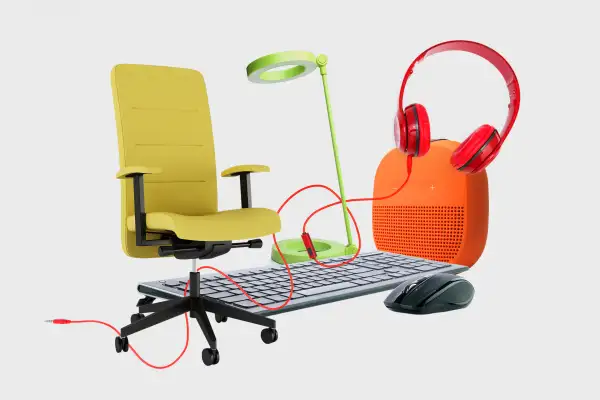Your Home Office Is Probably Wreaking Havoc on Your Body. Here Are Some Easy Upgrade Ideas for Every Budget

Like many employees at the start of the pandemic, 35-year old Hyedi Nelson assumed that when she switched to remote work, it wouldn’t be for long. So the Minneapolis-based public relations account director didn’t give much thought to “optimizing” her home office workstation.
“I removed a bunch of junk from my desk, put my laptop down, and got to work,” Nelson says. “I found out pretty quickly that this approach wasn’t ideal.”
Before long, Nelson started feeling aches and pains in her back, neck, and both of her wrists. As the days stretched into weeks, the pain got worse, and she knew something had to change.
Her experience is a common one. Having to pivot on short notice from in-office workstations to thrown-together home offices is making many Americans issue a collective groan as their body parts rebel from necks bent to funny angles, bunched up shoulders, and aching backs. With no end in sight for some remote workers, many are having to re-consider the ergonomics of their home office (or whatever room happens to be doubling as one).
Nelson, for her part, made a few simple tweaks to her office set up. She also invested in an Apple mouse, an elevated monitor, and a laptop stand for about $150 total — all of which help her work much more comfortably, she says.
If you're in the market for a new WFH setup, here's how to take a page from her book.
Budget upgrades ($20 to $50)
Jamie Gold, a wellness coach and author of Wellness by Design, says you don’t have to spend an arm and a leg on your home office setup. Small purchases like a good desk lamp will go a long way — especially if your “home office” is actually your bedroom, kitchen, or nursery.
If you’re using a standing desk, consider adding an anti-fatigue mat. Similar to what you might see a cashier using in a retail check-out lane, these cushioned, foam mats aim to reduce body fatigue. You can find versions on Amazon and office furniture stores for about $30.
Another affordable, easy upgrade is blue-light blocking glasses, which retail for about $20 (though prescription versions cost more). They're designed to filter out the blue light from screens—which may lower melatonin and impact sleep—and could help ease eye strain in the age of non-stop Zoom meetings.
Check your computer set up, too. For some people, the wrong keyboard can lead to muscle strain and conditions like carpal tunnel syndrome. Switching to a wireless keyboard or one with a shape that allows for more natural hand and wrist positioning can sometimes help.
Luxury upgrades ($50 and up)
If you have a little more room in your budget, Gold recommends investing in a good office chair.
Sitting for long periods can lead to a host of health issues, including poor posture, back discomfort, and down the road, illnesses linked to chronic inactivity like heart disease and diabetes.
Quality chairs with ergonomic design don’t come cheap, but they’re worth it, according to Gold. She recommends the popular Herman Miller Aeron Chair, which retails at a pricey $1,395, if new. There are plenty of sites that sell used or refurbished versions of the chair: Try eBay, Craigslist, and second-hand office furniture retailers.
“A good quality, ergonomic desk chair will last you for years,” Gold says.
If you've already got a solid chair, consider adding a “sit-to-stand attachment" to your workstation, a $200 upgrade that allows home office workers to raise and lower their desks seamlessly.
“This has been a game-changer for me,” says Pamela Skaufel, a 46-year old HR operations manager in Houston. “Now when I’m on a two-hour conference call, I can move around instead of being stuck in my chair the entire time.”
Skaufel also added a second, large monitor to her workspace.
“It allows me to be productive without having to flip back and forth between tabs, and it’s also easier on my body because I’m not staring at one particular spot all day,” she says.
Free upgrades (literally $0)
Here's a tip for combatting mid-day aches and pains that won't cost you anything: Get up and move around more.
Gold is a big proponent of this. “I do what I call ‘dance between drafts,’” she says. “I’ll choose a natural pause point between tasks, turn up my music, and dance around my office for the length of a favorite song. Then I'll step outside on my patio for a fresh-air moment.”
Another (completely free) consideration? Try positioning your workstation near a window, if it's available to you. This won't necessarily improve ergonomics, but it can reduce overall stress, which is great for your overall health.
“Nature views are proven elements of healing,” Gold says. “So if you have them close by, take full advantage.”